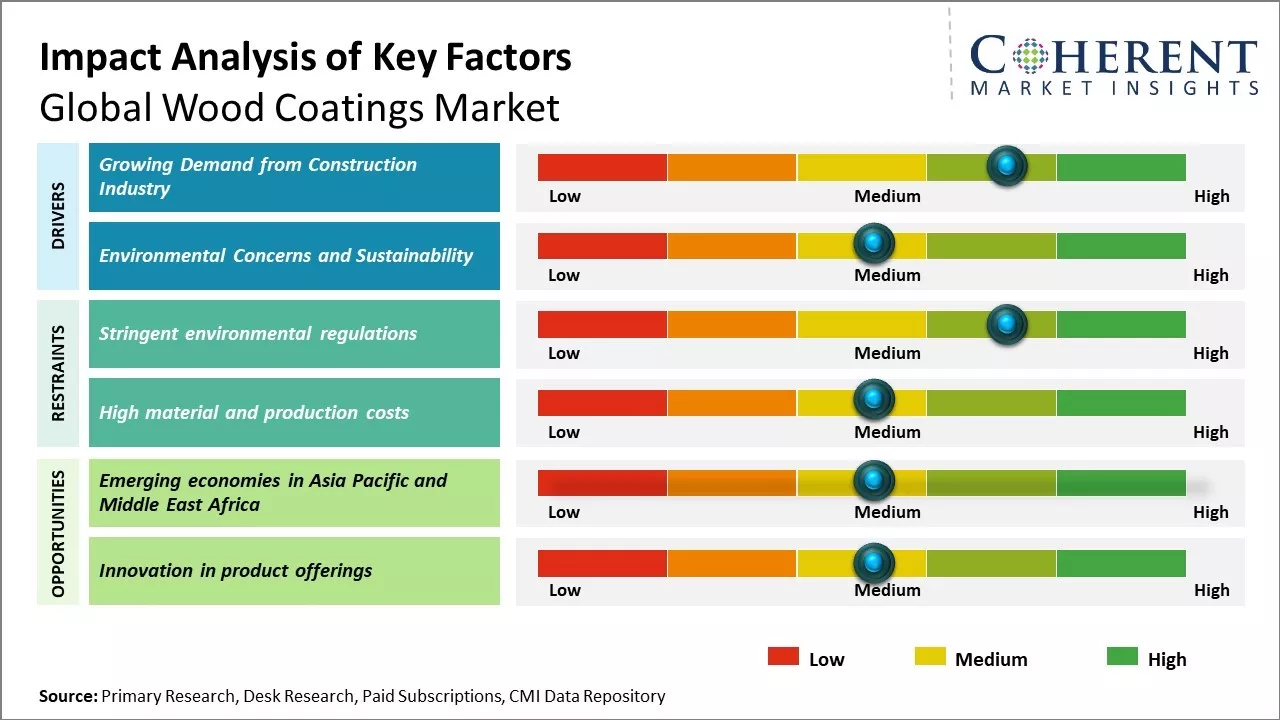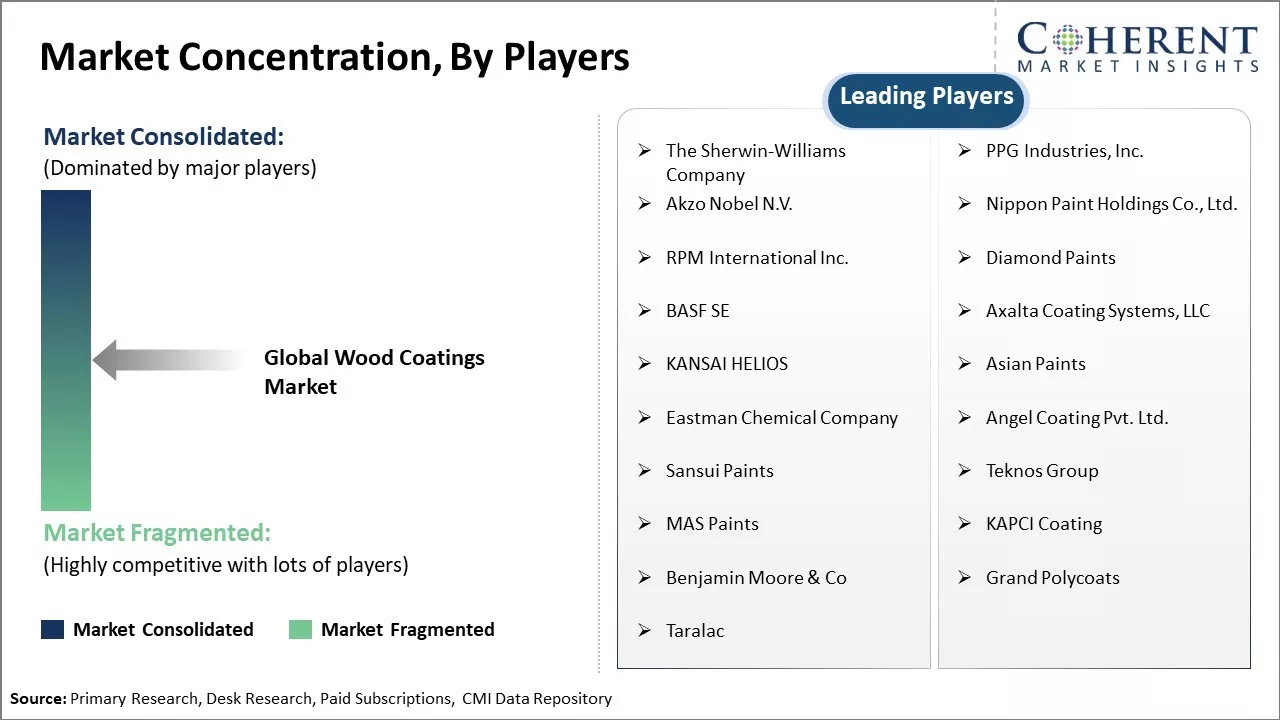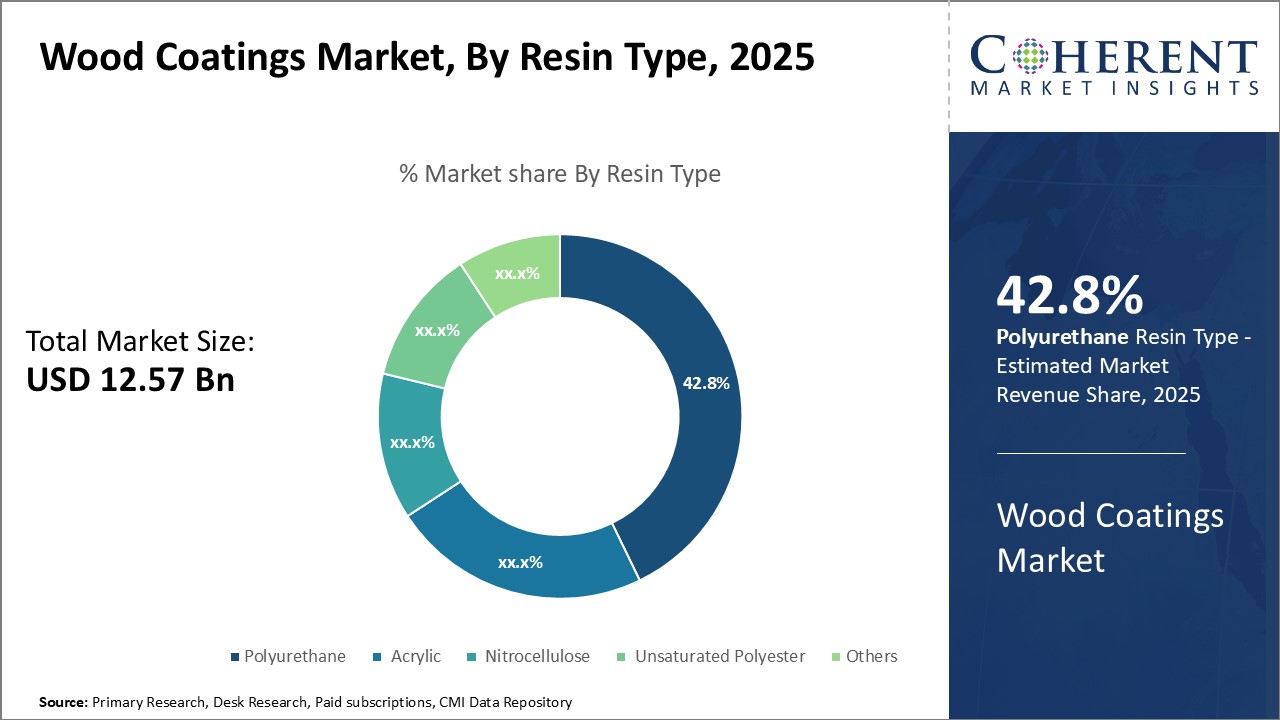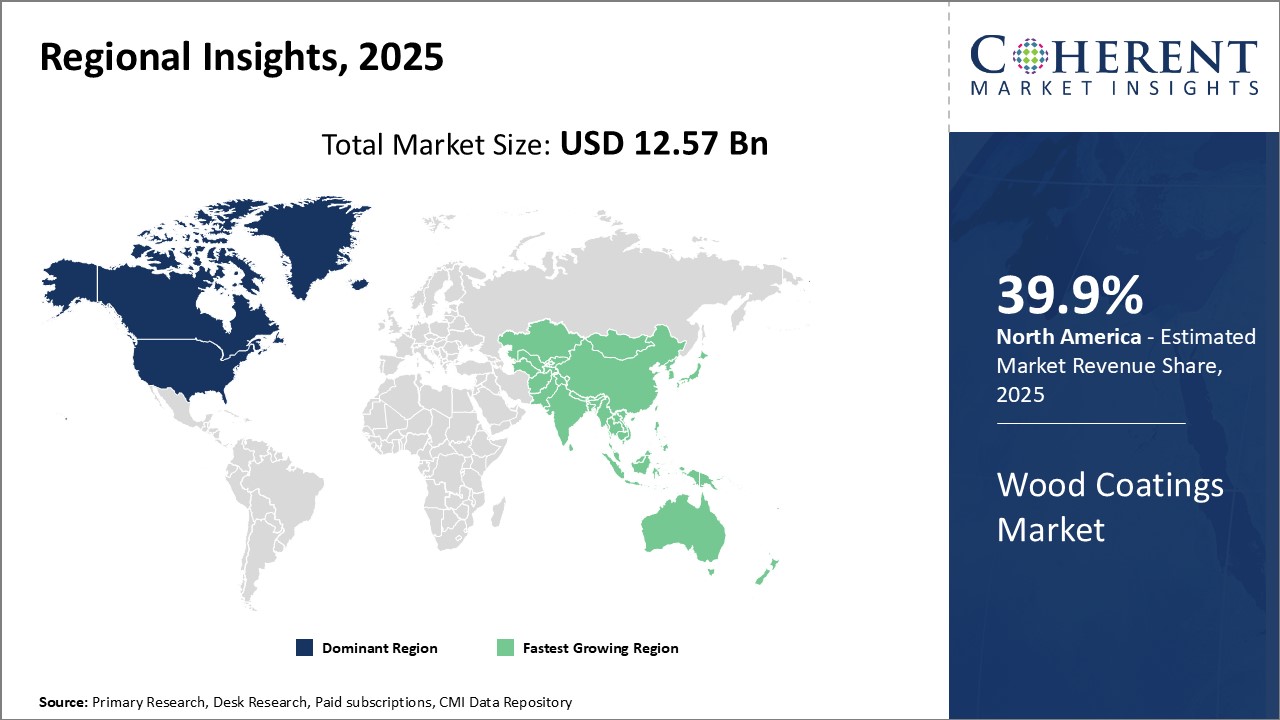The global wood coatings market is estimated to be valued at USD 12.57 Bn in 2025 and is expected to reach USD 17.70 Bn by 2032, exhibiting a compound annual growth rate (CAGR) of 5.0% from 2025 to 2032.

Discover market dynamics shaping the industry: Request sample copy
Rapid growth in the construction sector and increase in remodeling and renovation activities are expected to drive the demand for wood coatings globally during the forecast period. The wood coatings market is anticipated to witness significant growth on account of rising spending on home improvement and increasing consumer preference towards wood finishes. Furthermore, growing concerns regarding sustainability and emphasis on green buildings are augmenting the demand for eco-friendly wood coatings. Innovation in formulation and introduction of bio-based and low VOC coatings will further aid the business expansion over the next few years.
Growing Demand from Construction Industry
The global construction industry has been experiencing steady growth over the past few years and this growth is expected to continue going forward. There has been a rising population worldwide which is translating to increased construction of residential and commercial buildings. Both developing and developed countries are witnessing major infrastructure projects in areas like transportation, energy, and utilities. All these construction activities require huge quantity of wood products, which, in turn, drives the demand for wood coatings. Whether it is for doors, windows, furniture, or other structural applications, wood offers advantages like sustainability, stability, and aesthetics. In order to protect wood from outer environment including weathering, corrosion, and degradation, coatings play a very important role. They help in improving the lifespan of wood substantially. With the persistent growth trends in construction, wood consumption will keep rising worldwide, thereby augmenting the market for wood coatings as protecting wood remains critical.

Get actionable strategies to beat competition: Request sample copy
Environmental Concerns and Sustainability
Globally, the drive towards environment protection and sustainability has gained strong momentum in recent years. More companies and consumers are becoming conscious about using eco-friendly products. In the coatings industry also, this change is visible with growing preference for green coating solutions. Wood is one of the most sustainable and eco-friendly building materials available. However, conventional coating chemicals contain toxic components which release harmful pollutants into environment. There is rising emphasis on developing bio-based, natural, and low VOC coatings for wood. Manufacturers are focusing on innovations to formulate coatings with renewable resources and minimal environmental impact. Standard paints and varnishes are extensively researched and redesigned to make them greener. Both regulatory push and customer demand are favoring such sustainable wood coatings. Many developed nations have implemented stringent norms to curb hazardous emissions from coatings. This changing regulatory scenario and customer attitudes towards sustainability present significant market opportunities for green wood coatings.
Key Takeaways from Analyst:
The global wood coatings market is expected to grow steadily driven by increasing utilization of wood in residential and non-residential construction activities. Wood is increasingly becoming a preferred choice of material owing to its aesthetic look and environment-friendly nature. This will augment the demand for wood coatings globally.
Rising spending abilities which is allowing customers to opt for wood furnishings over conventional alternatives. However, volatile raw material prices may act as a restraint for market players as fluctuations in crude oil can impact prices of resins and solvents which are primary ingredients in wood coatings.
In terms of opportunities, water-based and powder wood coatings are expected to gain widespread acceptance on account of their relatively lower VOC content. Moreover, ongoing research towards bio-based resins is expanding viable choices for the manufacturers. The increased popularity of eco-friendly wood coatings will open new avenues for market expansion.
Market Challenges: Stringent environmental regulations
Stringent environmental regulations implemented by various governments are posing challenges for the growth of the global wood coatings market. Many countries have passed laws aimed at reducing VOC (volatile organic compound) emissions from industrial and commercial activities to mitigate air and water pollution. Since wood coatings contain solvents that release VOCs during application and drying processes, their formulations need to comply with new emission standards. This is requiring coatings manufacturers to invest heavily in research and development of lower VOC and zero VOC coating technologies. Transitioning to greener coatings has proven to be a costly and time intensive shift. Formulating products that meet performance requirements while keeping VOC levels within prescribed limits is a complex task. Manufacturers have to evaluate numerous resin system and solvent options before arriving at viable solutions. Testing and certification processes for new products also prolong the development cycle. The additional R&D expenses involved in creating sustainable coatings are restricting investments toward capacity expansions by manufacturers. Some smaller players struggling with the regulatory compliance costs are forced to shut down operations impacting market competition.
Market Opportunities: Emerging economies in Asia Pacific and Middle East Africa
Emerging economies in the Asia Pacific and Middle East Africa regions provide immense opportunities for growth in the global wood coatings market. These regions are experiencing rapid infrastructural development and urbanization at an unprecedented pace. According to World Bank data, the urban population in East Asia & Pacific is expected to rise to 67% by 2030 from 53% in 2020. Countries like China, India and Indonesia are focusing on infrastructure, real estate and construction projects to meet the demands of growing urban populations and rising GDP. This would require massive amounts of wood and wood products for applications like furniture, flooring, cladding and beams.

Discover high revenue pocket segments and roadmap to it: Request sample copy
Insights by Resin Type: Driving durability and aesthetics, polyurethane contributes the highest share
In terms of resin type, polyurethane is expected to contribute 42.8% share of the global wood coatings market in 2025, owing to its outstanding performance properties. Polyurethane coatings exhibit excellent durability and chemical resistance, protecting wood surfaces from wear, moisture, chemicals and UV degradation. They form a tough, flexible, and abrasion resistant film on wooden substrates. Polyurethane coatings are highly durable and protect wood from weathering for many years with minimum maintenance. They provide long-lasting protection for wood used in high traffic areas and harsh exterior environments.
Polyurethane coatings also deliver superior aesthetics. They are available in a wide range of gloss levels and can be easily tinted to desired colors. Polyurethane finishes lend an elegant, glossy and protective look to wood surfaces. They greatly enhance the natural beauty of wood grain and are commonly used for coating furniture, flooring and architectural woodwork. Polyurethane further increases the value of wood products through an appealing and luxurious visual appeal. Its outstanding durability and aesthetic qualities drive widespread adoption of polyurethane coatings in applications requiring both functionality and appearance.
Insights by Technology: Optimizing application process, Solvent-borne technology dominates
In terms of technology, solvent-borne coatings is expected to contribute 36.9% share of the global wood coatings market in 2025, due to advantages in the application process. Solvent-borne coatings have lower viscosity compared to other technologies, such as waterborne, allowing for improved penetration and adhesion to wood surfaces. The solvent helps the coating dry faster through evaporation after application. This significantly increases production speed and throughput for wood product manufacturers.
The flow and leveling properties of solvent-borne coatings also ensure excellent appearance with minimal brush marks or laps. This facilitates uniform and aesthetically pleasing finishes in large wood surfaces. Any imperfections can be easily smoothed during application. Further, solvents provide strong bonding to wood fibers, forming durable protective layers. Cleanup of application equipment is also simpler with solvents compared to other technologies.
Collectively, the process optimization driven by properties like lower viscosity, fast drying and ease of application and cleanup provide compelling reasons for continued preference of solvent-borne wood coatings in industrial production processes. This positions solvent-borne technology as the leader in the global market.
Insights by Application: Aesthetic appeal drives demand in furniture applications
In terms of application, furniture is expected to contribute 41.3% share of the global wood coatings market in 2025. This is mainly due to strong emphasis on aesthetic qualities in wood furniture finishes. Wooden furniture is a prominent part of interior décor and home design. An appealing furniture finish greatly enhances the look and feel of living spaces. Finely crafted wooden furniture pieces serve as statement pieces that represent the owner’s style and personality.
Coatings play a crucial role in bringing out the innate beauty in wood grains used for furniture. They lend a glossy, matte, satin, or other specialized finish according to the desired aesthetic. This aesthetic edge allows furniture makers to tap into demand and command premium prices. Furniture coatings are frequently customized with novel formulations, unique pigments, and special effects to lend furniture pieces a distinct and visually appealing character.
Complementing aesthetic qualities, coatings also protect the long-term finish of wooden furniture used in everyday living environments. They prevent damage from scratches, moisture, fading and stains to maintain the furniture’s pristine look. This longevity of appearance retains furniture value over its lifespan. The combined advantages of enhanced visual appeal and protection have made coated wood a top choice for high-quality, attractive, and durable furniture sought by discerning consumers.

Need a Different Region or Segment? Customize now
North America has been dominant in the global wood coatings market for a long period of time owing to well-established construction and furniture industries in the region. The region is expected to account for 39.9% of the market share in 2025. Countries like the U.S. and Canada have seen consistent growth in housing and non-residential construction activities over the years. This has significantly driven the demand for wood coatings from various end-use industries. Moreover, major wood coating manufacturers have their strong presence in North America by having production and R&D facilities across key markets. The manufacturers also emphasis on new product innovations to match evolving consumer trends. For instance, low VOC content coatings are gaining popularity due to stringent environmental regulations regarding VOC emissions.
One of the fastest growing regions in the global wood coatings market is Asia Pacific. The growth can be attributed to rapid urbanization and rising disposable income in developing economies like China and India. Both the countries are witnessing substantial investments in infrastructure and construction sectors. Additionally, growing middle-class population is propelling the sales of furniture and wood flooring, thereby augmenting coatings demand. Asian coatings producers are also enhancing their product offerings by incorporating advanced technologies and customized solutions. For example, water-based coatings are being widely supplied to meet strict health standards. Furthermore, economic development has enabled Asia Pacific to emerge as a major exporter of wooden furniture to Europe and North America. This is giving considerable impetus to wood production and processing industries in the region. Also, improving standard of living has increased consumption of wooden decorative and premium household goods.
Wood Coatings Market Report Coverage
| Report Coverage | Details | ||
|---|---|---|---|
| Base Year: | 2024 | Market Size in 2025: | USD 12.57 Bn |
| Historical Data for: | 2020 To 2024 | Forecast Period: | 2025 To 2032 |
| Forecast Period 2025 to 2032 CAGR: | 5.0% | 2032 Value Projection: | USD 17.70 Bn |
| Geographies covered: |
|
||
| Segments covered: |
|
||
| Companies covered: |
The Sherwin-Williams Company, PPG Industries, Inc., Akzo Nobel N.V., Nippon Paint Holdings Co., Ltd., RPM International Inc., Diamond Paints, BASF SE, Axalta Coating Systems, LLC, KANSAI HELIOS, Asian Paints, Eastman Chemical Company, Angel Coating Pvt. Ltd., Sansui Paints, Teknos Group , MAS Paints , KAPCI Coating , Benjamin Moore & Co, Grand Polycoats, and Taralac |
||
| Growth Drivers: |
|
||
| Restraints & Challenges: |
|
||
Uncover macros and micros vetted on 75+ parameters: Get instant access to report
*Definition: The global wood coatings market consists of companies that manufacture and supply various types of paints, stains, and varnishes used for coating and protecting wood surfaces. The coatings shield wood from threats like moisture, ultraviolet radiation, insects, microbes, etc. and help enhance its aesthetic appeal.
Share
Share
About Author
Yash Doshi is a Senior Management Consultant. He has 12+ years of experience in conducting research and handling consulting projects across verticals in APAC, EMEA, and the Americas.
He brings strong acumen in helping chemical companies navigate complex challenges and identify growth opportunities. He has deep expertise across the chemicals value chain, including commodity, specialty and fine chemicals, plastics and polymers, and petrochemicals. Yash is a sought-after speaker at industry conferences and contributes to various publications on topics related commodity, specialty and fine chemicals, plastics and polymers, and petrochemicals.
Missing comfort of reading report in your local language? Find your preferred language :
Transform your Strategy with Exclusive Trending Reports :
Frequently Asked Questions
Joining thousands of companies around the world committed to making the Excellent Business Solutions.
View All Our Clients
US Reciprocal Tax Impact Analysis On Wood Coatings Market
Stay updated on tariff changes with expert insights and timely information